Astragalus polysaccharides alleviates glucose toxicity and restores glucose homeostasis in diabetic states via activation of AMPK
- PMID: 19960007
- PMCID: PMC4007496
- DOI: 10.1038/aps.2009.168
Astragalus polysaccharides alleviates glucose toxicity and restores glucose homeostasis in diabetic states via activation of AMPK
Abstract
Aim: To establish the mechanism underlying the improvement of glucose toxicity by Astragalus polysaccharide (APS), which occurred via an AMP activated protein kinase (AMPK)-dependent pathway.
Methods: In vivo and in vitro effects of APS on glucose homeostasis were examined in a type 2 diabetes mellitus (T2DM) rat model. The T2DM rat model was duplicated by a high-fat diet (58% fat, 25.6% carbohydrate, and 16.4% protein) and a small dose of streptozotocin (STZ, 25 mg/kg, ip). After APS therapy (700 mg.kg(-1).d(-1), ig) for 8 weeks, blood glucose, glycosylated hemoglobin, and serum insulin were measured. Insulin sensitivity was evaluated by the comprehensive analysis of oral glucose tolerance tests (OGTT) and HOMA IR index. Hepatic glycogen was observed by the PAS staining method. The expression and activity of skeletal muscle AMPKalpha and acetyl-CoA carboxylase (ACC), and the phosphorylation of hepatic glycogen synthase (GS), the glycogen synthase (GS),were measured by Western blotting. Glucose uptake was measured with the 2-deoxy-[(3)H]-D-glucose method in C2C12 cells.
Results: The hyperglycemia status, insulin sensitivity, glucose uptake, and activation level of AMPK in diabetic rats were improved in response to APS administration. APS could also alleviate glucose toxicity in cultured mouse cells by the activation of AMPK.
Conclusion: APS can alleviate glucose toxicity by increasing liver glycogen synthesis and skeletal muscle glucose translocation in the T2DM rat model, via activation of AMPK.
Figures
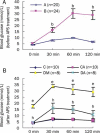

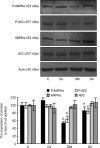
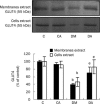
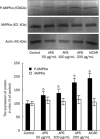

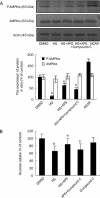
Similar articles
-
Mechanisms of Inonotus obliquus (Fr.) Pilát polysaccharides in ameliorating lipid-induced skeletal muscle insulin resistance via PI3K/AKT and AMPK/ACC1/CPT1 signaling pathways.J Ethnopharmacol. 2025 Jun 12;349:119938. doi: 10.1016/j.jep.2025.119938. Epub 2025 May 8. J Ethnopharmacol. 2025. PMID: 40348308
-
Astragalus polysaccharide reduces hepatic endoplasmic reticulum stress and restores glucose homeostasis in a diabetic KKAy mouse model.Acta Pharmacol Sin. 2007 Dec;28(12):1947-56. doi: 10.1111/j.1745-7254.2007.00674.x. Acta Pharmacol Sin. 2007. PMID: 18031609
-
Antidiabetic activity of Ganoderma lucidum polysaccharides F31 down-regulated hepatic glucose regulatory enzymes in diabetic mice.J Ethnopharmacol. 2017 Jan 20;196:47-57. doi: 10.1016/j.jep.2016.11.044. Epub 2016 Nov 27. J Ethnopharmacol. 2017. PMID: 27902927
-
Metabolism and insulin signaling in common metabolic disorders and inherited insulin resistance.Dan Med J. 2014 Jul;61(7):B4890. Dan Med J. 2014. PMID: 25123125 Review.
-
A spotlight on underlying the mechanism of AMPK in diabetes complications.Inflamm Res. 2021 Sep;70(9):939-957. doi: 10.1007/s00011-021-01488-5. Epub 2021 Jul 28. Inflamm Res. 2021. PMID: 34319417 Review.
Cited by
-
Upregulation in Inflammation and Collagen Expression in Perirenal but Not in Mesenteric Adipose Tissue from Diabetic Munich Wistar Frömter Rats.Int J Mol Sci. 2023 Nov 30;24(23):17008. doi: 10.3390/ijms242317008. Int J Mol Sci. 2023. PMID: 38069331 Free PMC article.
-
Astragalus Polysaccharide Extends Lifespan via Mitigating Endoplasmic Reticulum Stress in the Silkworm, Bombyx mori.Aging Dis. 2019 Dec 1;10(6):1187-1198. doi: 10.14336/AD.2019.0515. eCollection 2019 Dec. Aging Dis. 2019. PMID: 31788331 Free PMC article.
-
Pharmacological Effects and Molecular Protective Mechanisms of Astragalus Polysaccharides on Nonalcoholic Fatty Liver Disease.Front Pharmacol. 2022 Mar 3;13:854674. doi: 10.3389/fphar.2022.854674. eCollection 2022. Front Pharmacol. 2022. PMID: 35308224 Free PMC article. Review.
-
A Systematic Review of Phytochemistry, Pharmacology and Pharmacokinetics on Astragali Radix: Implications for Astragali Radix as a Personalized Medicine.Int J Mol Sci. 2019 Mar 22;20(6):1463. doi: 10.3390/ijms20061463. Int J Mol Sci. 2019. PMID: 30909474 Free PMC article.
-
System Pharmacology-Based Dissection of the Synergistic Mechanism of Huangqi and Huanglian for Diabetes Mellitus.Front Pharmacol. 2017 Oct 5;8:694. doi: 10.3389/fphar.2017.00694. eCollection 2017. Front Pharmacol. 2017. PMID: 29051733 Free PMC article.
References
-
- Kiberstis PA. A surfeit of suspects (special section–type 2 diabetes) Science. 2005;307:1–2016.
-
- Sewter C, Vidal-Puig A. PPARgamma and the thiazolidinediones: molecular basis for a treatment of 'Syndrome X'. Diabetes Obes Metab. 2002;4:239–48. - PubMed
-
- Leverve XM, Guigas B, Detaille D, Batandier C, Koceir EA. Mitochondrial metabolism and type-2 diabetes: a specific target of metformin. Diabetes Metab. 2003;29:6S88–94. - PubMed
-
- Grover JK, Yadav S, Vats V. Medicinal plants of India with antidiabetic potential. J Ethnopharmacol. 2002;81:81–100. - PubMed
-
- Mao CP, Xie ML, Gu ZL. Effects of konjac extract on insulin sensitivity in high fat diet rats. Acta Pharmacol Sin. 2002;23:855–9. - PubMed
Publication types
MeSH terms
Substances
LinkOut - more resources
Full Text Sources
Medical
Miscellaneous

